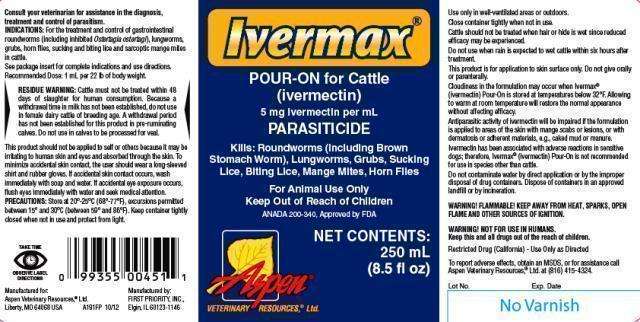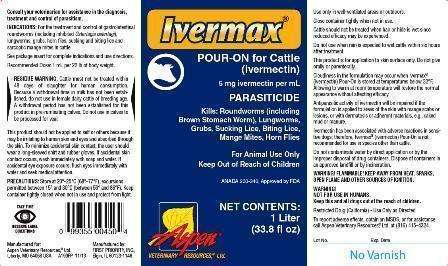Ivermax
IvermaxPOUR-ON for Cattle (ivermectin)
FULL PRESCRIBING INFORMATION: CONTENTS*
- Parasiticide
- Introduction
- Indications
- Dosage
- Mode of Action
- RESIDUE WARNING:
- Animal Safety
- PRECAUTIONS:
- When to Treat Cattle with Grubs
- Environmental Safety
- Package Information:
- Image of 250 mL label
- Image of 1.0 Liter (1000 mL) bottle
- Image of 2.5 Liter label
- Image of 5.0 Liter label
FULL PRESCRIBING INFORMATION
Parasiticide
Consult your veterinarian for assistance in the diagnosis, treatment and control of parasitism.
Introduction
Ivermectin Pour-On for Cattle delivers internal and external parasite control in one convenient low-volume application.
Ivermectin is a potent anti-parasitic agent whose chemical structure is different from those of other anti-parasitic agents.
Indications
Ivermectin Pour-On for Cattle applied at the recommended dose level of 500 mcg/kg is indicated for the effective control of these parasites.
Gastrointestinal Roundworms
Ostertagia ostertagi (adults and L4)
(including inhibited stage)
Haemonchus placei (adults and L4)
Trichostrongylus axei (adults and L4)
T. colubriformis (adults and L4)
Cooperia oncophora (adults and L4)
Cooperia punctata (adults and L4)
Cooperia surnabada (adults and L4)
Strongyloides papillosus (adults)
Oesophagostomum radiatum (adults and L4)
Trichuris spp (adults)
Lungworms
Dictyocaulus viviparus (adults and L4)
Cattle Grubs (parasitic stages)
Hypoderma bovis
H. lineatum
Mites
Sarcoptes scabiei var. Bovis
Lice
Linognathus vituli
Haematopinus eurystemus
Damalinia bovis
Solenopotes capillatus
Horn Flies
Haematobia irritans
Persistent Activity
Ivermectin Pour-On for Cattle (ivermectin) has been proved to effectively control infections and to protect cattle from re-infection with: Oesophagostomum radiatum and Dictyocaulus viviparous for 28 days after treatment; Cooperia punctata and Trichostrongylus axei for 21 days after treatment; Ostertagia ostertagi, Haemonchus placei, Cooperia oncophora and Cooperia surnabada for 14 days after treatment; Damalinia bovis for 56 days after treatment.
Treatment for Cattle for Horn Flies
Ivermectin Pour-On for Cattle (ivermectin) controls horn flies (Haematobia irritans) for up to 28 days after dosing. For best results Ivermectin Pour-On for Cattle (ivermectin) should be part of a parasite control program for both internal and external parasites based on the epidemiology of these parasites. Consult your veterinarian or an entomologist for the most effective timing of applications.
Dosage
The dose rate is 1 mL for each 22 lb of body weight. The formulation should be applied along the topline in a narrow strip extending from the withers to the tailhead.
Administration
Measuring Cup (250 mL, 1 L and 1 gallon bottles).
The enclosed measuring cup is graduated in 5 mL increments. Each 5 mL will treat 110 lbs body weight. When body weight is between markings, use the next higher increment.
Applicator Gun*
(2.5 L, 5 L and 5 gallon bottles)
Because of the solvents used in Ivermectin Pour-On for Cattle (ivermectin), the applicator gun from Genesis Instruments (EZ Doser™ or Power Doser™) or equivalent is recommended. Other applicators may exhibit compatibility problems, resulting in locking, incorrect dosage or leakage.
EZ Doser™ Operation:
- Set the recommended dosage by turning the dose adjuster.
- To prime the system, squeeze the handles repeatedly. This draws the fluid out of the container and into the EZ Doser™ barrel.
- To expel air out of the system, hold the EZ Doser™ in a vertical position and gently squeeze the handles until the air is purged.
- EZ Doser™ is activated by squeezing the handles. The pre-set dose will be given each time. The EZ Doser™ will automatically refill after each use.
Power Doser™ Operation:
- Set the recommended dosage by turning the dose adjuster.
- Bleed the line with rapid actuation of the Power Doser™.
- Empty the air in the barrel by actuating the system so that the barrel fills 100% with product.
- Power Doser™ is activated by squeezing the knob. Power Doser™ will automatically refill after each use.
Follow the applicator gun manufacturer’s directions for priming the gun, adjusting the dose, and care of the applicator gun following use.
| 220 lb (100 kg) / 10 mL |
| 330 lb (150 kg) / 15 mL |
| 440 lb (200 kg) / 20 mL |
| 550 lb (250 kg) / 25 mL |
| 660 lb (300 kg) / 30 mL |
| 770 lb (350 kg) / 35 mL |
| 880 lb (400 kg) / 40 mL |
| 990 lb (450 kg) / 45 mL |
| 1100 lb (500 kg) / 50 mL |
*Additional applicator guns can be purchased from Genesis Instruments, Elmwood, Wisconsin.
Mode of Action
Ivermectin as a member of the avermectin family kills certain parasitic roundworms and ectoparasites, such as mites, lice, horn flies and other insects. Its action is unique to the avermectin class of antiparasitic agents. This action involves a chemical that serves as a signal from one nerve cell to another, or from a nerve cell to a muscle cell. This chemical, a neurotransmitter, is called gamma-aminobutyric acid or GABA.
In roundworms, ivermectin stimulates the release of GABA from nerve endings and enhances binding of GABA to special receptors at nerve junctions, thus interrupting nerve impulses - there by paralyzing and killing the parasite.
The enhancement of the GABA effect in arthropods such as mites, lice, and horn flies resembles that in roundworms, except that nerve impulses are interrupted between the nerve ending and the muscle cell. Again, this leads to paralysis and death.
Ivermectin has no measurable effect against flukes or tapeworms, presumably because they do not have GABA as a nerve impulse transmitter.
RESIDUE WARNING:
Cattle must not be treated within 48 days of slaughter for human consumption. Because a withdrawal time in milk has not been established, do not use in female dairy cattle of breeding age. A withdrawal period has not been established for this product in pre-ruminating calves. Do not use in calves to be processed for veal.
The principle peripheral neurotransmitter in mammals, acetylcholine, is unaffected by invermectin. Ivermectin does not readily penetrate the central nervous sytem of mammals where GABA functions as a neurotransmitter.
Animal Safety
Studies conducted in the U.S.A. have demonstrated the safety margin for ivermectin. Based on plasma levels, the topically applied formulation is expected to be at least as well tolerated by breeding animals as is the subcutaneous formulation which had no effect on breeding performance.
WARNING! NOT FOR USE IN HUMANS
This product should not be applied to self or others because it may be irritating to human skin and eyes and absorbed through the skin. To minimize accidental skin contact, the user should wear a long-sleeved shirt and rubber gloves. If accidental skin contact occurs, wash immediately with soap and water. If accidental eye exposure occurs, flush eyes immediately with water and seek medical attention.
Keep this and all drugs out of the reach of children.
WARNING! FLAMMABLE! KEEP AWAY FROM HEAT, SPARKS, OPEN FLAME, AND OTHER SOURCES OF IGNITION.
PRECAUTIONS:
Store at 20°-25°C (68°-77°F), excursions permitted between 15° and 30°C (between 59° and 86°F). Brief exposure to temperatures up to 40°C (104°F) may be tolerated provided the mean kinetic temperature does not exceed 25°C (77°F); however, such exposure should be minimized. Keep container tightly closed when not in use and protect from light.
Use only in well-ventilated areas or outdoors.
Close container tightly when not in use.
Cattle should not be treated when hair or hide is wet since reduced efficacy may be experienced.
Do not use when rain is expected to wet cattle within six hours after treatment.
This product is for application to skin surface only. Do not give orally or parenterally.
Cloudiness in the formulation may occur when Ivermectin Pour-On for Cattle is stored at temperatures below 32°F. Allowing to warm at room temperature will restore the normal appearance without affecting efficacy.
Antiparasitic activity of ivermectin will be impaired if the formulation is applied to areas of the skin with mange scabs or lesions, or with dermatosis or adherent materials, e.g., caked mud or manure.
Ivermectin has been associated with adverse reactions in sensitive dogs; therefore, Ivermectin Pour-On for Cattle is not recommended for use in species other than cattle.
When to Treat Cattle with Grubs
Ivermectin Pour-On for Cattle effectively controls all stages of cattle grubs. However, proper timing of treatment is important. For the most effective results, cattle should be treated as soon as possible after the end of the heel fly (warble fly) season. While this is not peculiar to ivermectin, destruction of Hypoderma larvae (cattle grubs) at the period when these grubs are in vital areas may cause undesirable host-parasite reactions. Killing Hypoderma lineatum when it is in the esophageal tissues may cause bloat; killing H. bovis when it is in the vertebral canal may cause staggering or paralysis. Cattle should be treated either before or after these stages of grub development.
Cattle treated with Ivermectin Pour-On for Cattle at the end of the fly season may be re-treated with Ivermectin Pour-On for Cattle during the winter without danger of grub-related reactions. For further information and advice on a planned parasite control program, consult your veterinarian.
Environmental Safety
Studies indicate that when ivermectin comes in contact with the soil, it readily and tightly binds to the soil and becomes inactive over time. Free ivermectin may adversely affect fish and certain aquatic organisms. Do not permit cattle to enter lakes, streams or ponds for at least six hours after treatment. Do not contaminate water by direct application or by the improper disposal of drug containers. Dispose of containers in an approved landfill or by incineration.
As with other avermectins, ivermectin is excreted in the dung of treated animals and can inhibit the reproduction and growth of pest and beneficial insects that use dung as a source of food and for reproduction. The magnitude and duration of such effects are species and life-cycle specific. When used according to label directions, the product is not expected to have an adverse impact on populations of dung- dependent insects.
For customer service, contact First Priority, Inc., 1590 Todd Farm Drive, Elgin, IL 60123-1146
Keep this and all drugs out of the reach of children. To report suspected adverse reactions, contact Aspen Veterinary Resources, Ltd. at 1-816-415-4324.
Manufactured By: FIRST PRIORITY, INC., 1590 Todd Farm Drive, Elgin, IL 60123-1146
ANADA 200-340, Approved by FDA
Contains 5 mg ivermectin/mL
Restricted Drug (California) - Use Only as Directed
Package Information:
Ivermectin Pour-On for Cattle is available in a 250 mL (8.5 fl oz), a 1 L (33.8 fl oz) and a 1 gallon (3.785 L) bottle for use with the measuring cup provided, a 2.5 L (84.5 fl oz) container, 5 L (169.0 fl oz) container, and a 5 Gallon (639.0 fl oz) container for use with the appropriate automatic dosing applicator.
Rev. 02-13
Image of 250 mL label

Image of 250 mL label (issue 06/13)
Image of 1.0 Liter (1000 mL) bottle

Image of 1.0 liter (issue 06/13) (expires: 10/15)

Image of 1.0 liter label (issue 11/13)
Image of 2.5 Liter label

Image of 2.5 liter label (rev. 06/13)

image of 2.5 liter label
(issued 06/09 - expires: 04/14)
Image of 5.0 Liter label

Image of 5.0 Liter label (revision 06/13)

image of 5.0 liter label
(issued 12/05 - expires: 10/13)
IvermaxIVERMECTIN CATTLE POUR-ON SOLUTION
| |||||||||||||||||||||||||||||||||||||||||||||||||||||||||||||||||||||